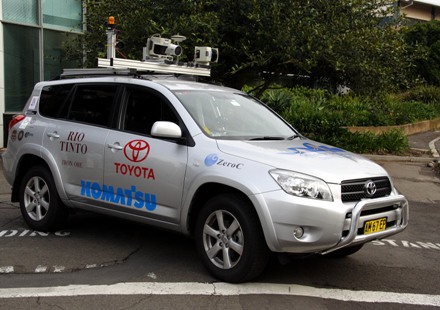Aussie team takes DARPA race smarts to business

An Australian team has used knowledge gained from the Defence Advanced Research Projects Agency (DARPA) Urban Challenge to help corporate and government projects, according to a team member.
The DARPA Urban Challenge started in 2004, where cars driven by computers compete in a challenge aimed at accelerating the development of autonomous vehicle technologies.
In this year's challenge, autonomous cars had to navigate in a mock city environment, merging into moving traffic, navigating traffic circles, negotiating busy intersections and avoiding obstacles.
The original starting line-up of 89 competitors featured a Berkeley-Sydney team -- a joint effort by The University of California Berkeley, The Australian Centre for Field Robotics (ACFR) at the University of Sydney, National ICT Australia (NICTA) and the University of Technology Sydney.
Although the team did not make the finals of the event, William Uther, the head of the team from NICTA, told ZDNet Australia that the different sections of the team would be putting their experiences to good use in business.
The ACFR's work with the Urban Challenge and autonomous technologies has helped with a project the Centre is working on with Australia's largest operator of container terminals, Patrick, to create an Automated Straddle Carrier.
The AutoStrad, as it has been named, is the "first free-ranging automated equipment in use in the port industry worldwide", according to Patrick. The Autostrad moves and stacks containers from the quay into holding yards, onto vehicles and back to quay cranes. It does not require any installations of in-ground nodes or wires to operate and works on a virtual computer-generated grid.
Uther said that participation in the DARPA Urban Challenge has also helped the ACFR in its partnership with global mining company Rio Tinto.
The ACFR has established a Centre for Mine Automation to which Rio Tinto has committed AU$21 million over five years. According to the ACFR, the aim of this centre is to develop and implement a fully autonomous, remotely operated mine.
Uther continued that the DARPA Urban Challenge has helped his team at NICTA with their work with the Roads and Traffic Authority, by giving insights into how traffic moves. The aim of NICTA's work is to improve traffic light controllers to help traffic flow and reduce congestion.
Eventually, Uther said, NICTA's goal is to get rid of lights entirely, and have a computer on each intersection instead. With autonomous cars that know when lights are about to change, the changeovers could be completed much quicker than if a human were driving it.
Unfortunately, according to Uther, these developments could be 30 years in the future.
While developing autonomous cards for the next century will require a lot of scientific manpower, this year's DARPA race presented its own challenges for Australia's team.
Uther told ZDNet Australia that the team got a late start to the event: "We were playing catch up", he said. Despite the delays, the team passed a test in April, winning the right to bring the car to America for the site visit qualifier in June.

The Berkeley-Sydney Car
Credit: NICTA
Uther said that although the car could complete the required course, it could only do it at a walking pace -- too slow for the challenge. Its reactions were also overly sensitive, with the car sometimes recognising a leaf as an obstacle.
He also said that the team's test area was "very realistic", with a lot of tree coverage, which wreaked havoc with the GPS system. According to Uther, most of the other teams used an open car park, and "when the other teams tried the [Sydney team's] course, all but 11 teams got knocked out".
The team did not pass the site round, but continued to fine tune the car. By the time of the finals, the car was good enough to have been able to qualify.
On the question of whether the Berkeley-Sydney team were looking to next year, Uther said that DARPA "haven't said they'll do any more". He added that the competitions were never meant to be once a year, saying that "there will probably be a delay until they come up with something significantly harder".
Uther said that his goal was to make the car capable of driving in Sydney traffic, but added: "Once the car comes to that level of competence, how do you test it?"